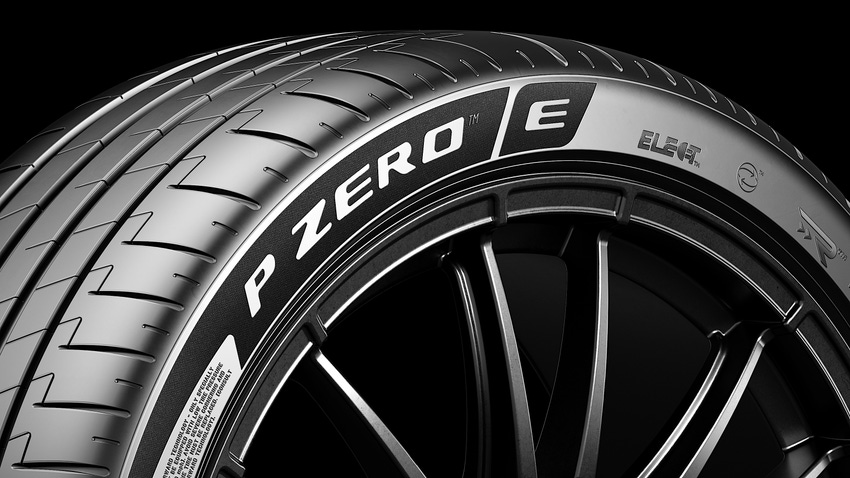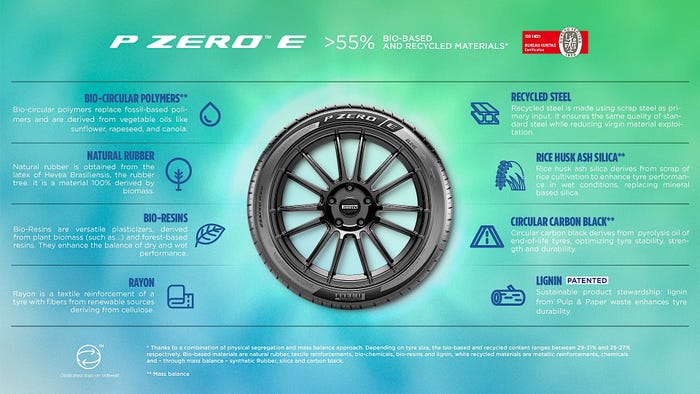Pirelli Tires Aren't Just Round, They're Circular!
The wheels on the bus may go ‘round and ‘round, but Pirelli is focused on a different kind of circularity for its tires.
April 24, 2024

At a Glance
- Bio-based materials
- Recycled materials
- Longer life before replacement
Tires are one of the most frequently recycled consumer products, with 94 percent of scrap tires getting reused for something according to the U.S. Tire Manufacturers Association. But Pirelli has a more aggressive goal: complete circularity of the materials that go into its tires.
That’s easier said than done, however, because when those components are combined to make tires, the chemical processes aren’t reversible, explained Maureen Kline, vice president for public affairs and sustainability for Pirelli North America. “You can’t un-bake a cake,” she noted. “What you get is not the same as what you put in, just like the eggs in a cake.”
The company’s latest demonstration of its work to make tires greener is the P Zero E, a tire optimized for electric vehicles that is made using more than 55 percent bio-based and recycled materials. Bio-based materials are natural rubber, textile reinforcements, bio-chemicals, bio-resins, and lignin. Recycled materials include steel reinforcement belts, chemicals, silica, and carbon black.
Similarly, as the exclusive tire supplier for the immensely popular Formula One racing series, Pirelli has earned Forest Stewardship Council certification that the rubber used for those short-lived tires does not contribute to deforestation. Additionally, the FSC certifies that human rights are respected and that biodiversity is preserved through the rubber harvesting process. “There is a chain of custody that follows that rubber to the factory and into the tire,” Kline explained. This certification is audited annually, she added.
The company is aiming to press forward with its current efforts, with the goal of improving the P Zero E’s bio-based and recycled content percentage from 55 percent to 80 percent by 2030, Kline said. Applying the know-how gained from the P Zero E will let Pirelli boost its overall portion of bio-based and recycled materials across all of its tires to 40 percent by that same time, she said.
“It is a business issue of resources,” explained Kline. “Just like battery recyclability is important, tire recyclability is important as well.” There are improvements to the tires that can help, but the solution is re-use. “We are trying to make tires lighter, stronger, and lasting longer, Kline noted. “Recycled material can help with the basic availability of resources.”
The materials that can be recovered from old tires and reused include the rubber after it has been devulcanized, the silica that is used to improve grip in slippery conditions, and the carbon black that boosts tire durability. Silica is silicon dioxide that can be recovered from rice husk ash, the product of burning the husks from harvested rice.
A 1992 report by Jack L. Koenig, “Spectroscopy of Polymers,” found that tires would last no more than 5,000 miles without the use of carbon black. The trouble is that recovered carbon black doesn’t work as well as virgin material. “The issue is how the [recycled] carbon black performs on the road,” said Kline.

Pirelli
The silica that improves traction in rain and snow has the effect of wearing more quickly, making carbon black’s durability contribution even more crucial than it was at the time of the report, which was before silica was introduced to car tires. A challenge for Pirelli is that the company specializes in high-performance car tires, which is an application where carbon black’s contribution is crucial.
Off-road tires and tires for economy cars are less taxing and can tolerate higher portions of lower-performance recycled carbon black, said Kline. This makes Pirelli’s use of the material a true bellwether, she pointed out. “If we made off-road tires, we could probably use more of that,” she said. “When Pirelli is able to increase that content, that’s when the industry will find [recycled carbon black] has reached the necessary level of quality.”
That’s when Pirelli tires will not only be round, but they’ll also be truly circular.
You May Also Like
.jpg?width=300&auto=webp&quality=80&disable=upscale)


